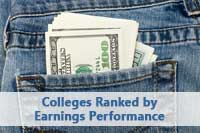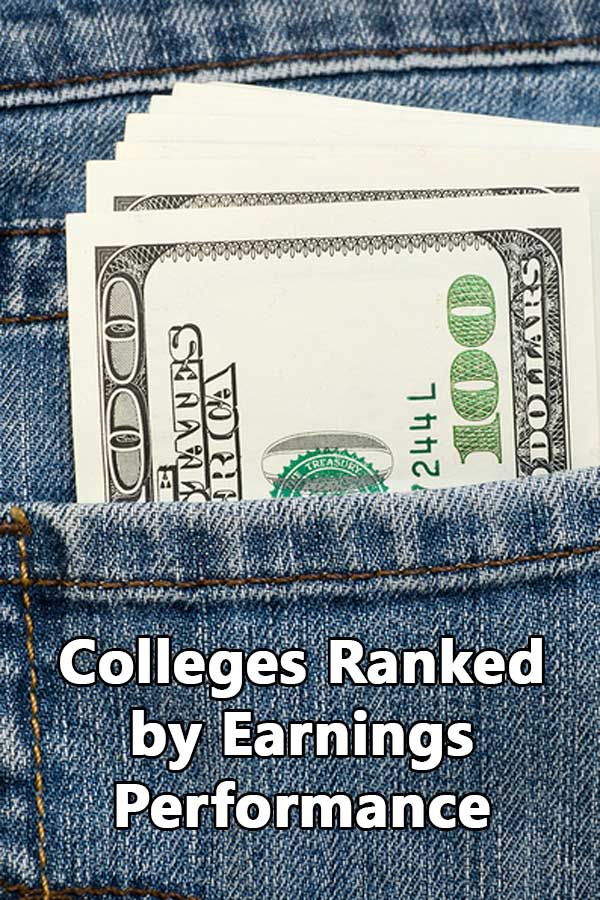 During last fall’s college rankings frenzy, I missed the Economist’s first ever contribution to the college rankings. Having taken some time to look over the list and methodology, I think they have something meaningful to contribute to comparing colleges. Like Money Magazine’s Rankings, the Economist is looking at the financial results of a college education. Unlike Money which focuses on the Return On Investment, the Economist’s college rankings are focused on the school effect.
During last fall’s college rankings frenzy, I missed the Economist’s first ever contribution to the college rankings. Having taken some time to look over the list and methodology, I think they have something meaningful to contribute to comparing colleges. Like Money Magazine’s Rankings, the Economist is looking at the financial results of a college education. Unlike Money which focuses on the Return On Investment, the Economist’s college rankings are focused on the school effect.
What does that mean? Assume that you cloned a student. You send clone A to college A and clone B to college B. Ten years after the clones graduate, you compare how much money they’re making. If clone A is making more money than clone B then you would conclude that college A was a better choice in terms of making money than college B.
I’m sure you can already see some of the issues in making such a comparison. What if one school produces engineers and the other is for musicians? What if one takes poorer students or the other only accepts students with high test scores?
The Economist recognized these issues. The rankings used regression analysis to determine how much these various factors accounted for in the ultimate earnings. For example, the rankings include the impact of SAT scores in dollar amounts. At #4 Harvard University, the students’ high SAT average is calculated to contribute $24,209 to expected earnings after 10 years. At #50 Sul Ross State University, a small public university in south Texas, the SAT average actually reduced the expected earnings because they are so low.
The analysis included dollar amounts for fields of study, public/private status, Liberal Arts Colleges, sex ratio, religion, Pell Grants, location, and other factors. Based on these factors, the Economist calculated an expected earnings for the college much the same way that the Washington Monthly and US News Best College rankings calculate an expected graduation rate. The Economist then compared the expected earnings to the actual earning reported in the College Scorecard. Colleges are ranked according to how much they overperformed or underperformed compared to their expected rankings.
This is why Sul Ross can be ranked 50th. The Economist calculated expected earnings of only $31,208. Yet, according to the College Scorecard, the average earnings after 10 years is $38,000 which means that students overperformed by $6,792.
Of course, there are all kinds of limitations to these rankings and I really don’t expect people to prefer Sul Ross to Yale because Yale only ranked at 1270. However, I think it’s perfectly reasonable for people to wonder why Yale ranked so much lower than Harvard.
Another issue to consider is cost. Unlike the Money rankings, the Economist’s college rankings don’t say anything about how much the student pays to attend the college. Is the overperformance of $5,000 in earnings after 10 years worth paying an additional $10,000 per year of college?
The list below includes the 32 50-50 Colleges that made the top 100 of the Economist’s college rankings. As usual, the 4 year rate is used for private schools and the 5 year for public.
50-50 Colleges in Economist’s Top 100 College Rankings
| Rank | Name | Type | State | Full-time Under-grads | 4/5 yr Grad Rate | Avg Net Price After Gift Aid (2012-2013) | Median Earnings of Students Working After 10 Years | Expected earnings | Over/ Under |
| 3 | Villanova University | Private | PA | 6,547 | 86 | $30,587 | $73,700 | $60,457 | $13,243 |
| 17 | Drake University | Private | IA | 3,185 | 61 | $26,330 | $55,700 | $46,904 | $8,796 |
| 21 | Duquesne University | Private | PA | 5,740 | 66 | $25,944 | $54,300 | $45,866 | $8,434 |
| 22 | University of Scranton | Private | PA | 3,756 | 75 | $32,348 | $56,000 | $47,567 | $8,433 |
| 23 | Rose-Hulman Institute of Technology | Private | IN | 2,186 | 66 | $36,613 | $78,900 | $70,535 | $8,365 |
| 27 | Linfield College-McMinnville Campus | Private | OR | 1,630 | 59 | $26,196 | $51,300 | $43,123 | $8,177 |
| 30 | Gwynedd Mercy University | Private | PA | 1,851 | 50 | $23,801 | $52,000 | $44,254 | $7,746 |
| 31 | Fairfield University | Private | CT | 3,546 | 79 | $36,853 | $69,000 | $61,344 | $7,656 |
| 37 | East Stroudsburg University of Pennsylvania | Public | PA | 5,495 | 54 | $14,437 | $42,900 | $35,584 | $7,316 |
| 39 | SUNY Oneonta | Public | NY | 5,675 | 69 | $14,667 | $42,400 | $35,156 | $7,244 |
| 40 | George Mason University | Public | VA | 17,261 | 61 | $16,155 | $57,000 | $49,804 | $7,196 |
| 41 | Western New England University | Private | MA | 2,498 | 52 | $29,070 | $55,100 | $47,943 | $7,157 |
| 43 | Georgetown College | Private | KY | 1,000 | 49 | $19,446 | $43,000 | $35,926 | $7,074 |
| 47 | Ithaca College | Private | NY | 6,131 | 69 | $32,769 | $50,400 | $43,533 | $6,867 |
| 48 | University of Vermont | Public | VT | 9,764 | 75 | $15,793 | $44,000 | $37,139 | $6,861 |
| 52 | Point Loma Nazarene University | Private | CA | 2,483 | 62 | $29,013 | $50,300 | $43,726 | $6,574 |
| 56 | Susquehanna University | Private | PA | 2,129 | 71 | $27,142 | $50,000 | $43,788 | $6,212 |
| 58 | Creighton University | Private | NE | 3,815 | 67 | $27,057 | $57,800 | $54,829 | $6,171 |
| 69 | Clarkson University | Private | NY | 3,084 | 61 | $25,782 | $68,400 | $62,437 | $5,963 |
| 72 | Providence College | Private | RI | 3,798 | 83 | $34,388 | $59,600 | $53,691 | $5,909 |
| 73 | Misericordia University | Private | PA | 1,790 | 64 | $24,545 | $47,500 | $41,649 | $5,851 |
| 75 | Butler University | Private | IN | 3,974 | 51 | $30,991 | $52,400 | $46,783 | $5,617 |
| 77 | James Madison University | Public | VA | 17,526 | 80 | $14,521 | $53,400 | $47,839 | $5,561 |
| 79 | West Virginia University | Public | WV | 21,027 | 53 | $9,826 | $43,900 | $38,414 | $5,486 |
| 80 | Illinois Wesleyan University | Private | IL | 2,001 | 72 | $28,044 | $54,600 | $49,120 | $5,480 |
| 81 | University of Utah | Public | UT | 17,319 | 49 | $11,702 | $49,300 | $43,833 | $5,467 |
| 84 | University of Redlands | Private | CA | 2,702 | 63 | $28,164 | $53,800 | $48,386 | $5,414 |
| 87 | Samford University | Private | AL | 2,850 | 49 | $25,626 | $45,800 | $40,413 | $5,387 |


1 thought on “50-50 Highlights: Colleges in the Economist’s Top 100 College Rankings”